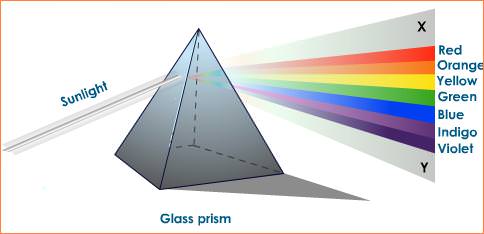[/caption]
Look up into the rainy sky! What do you see? Well, if its just rained and the sun is once again shining, chances are you see a rainbow. Always a lovely sight isn’t it? But why is it that after a rainstorm, the air seems to catch the light in just the right way to produce this magnificent natural phenomenon? Much like stars, galaxies, and the flight of a bumblebee, some complicated physics underlie this beautiful act of nature. For starters, this effect, where light is broken into the visible spectrum of colors, is known as the Dispersion of Light. Another name for it is the prismatic effect, since the effect is the same as if one looked at light through a prism.
To put it simply, light is transmitted on several different frequencies or wavelengths. What we know as “color” is in reality the visible wavelengths of light, all of which travel at different speeds through different media. In other words, light moves at different speed through the vacuum of space than it does through air, water, glass or crystal. And when it comes into contact with a different medium, the different color wavelengths are refracted at different angles. Those frequencies which travel faster are refracted at a lower angle while those that travel slower are refracted at a sharper angle. In other words, they are dispersed based on their frequency and wavelength, as well as the materials Index of Refraction (i.e. how sharply it refracts light).
The overall effect of this – different frequencies of light being refracted at different angles as they pass through a medium – is that they appear as a spectrum of color to the naked eye. In the case of the rainbow, this occurs as a result of light passing through air that is saturated with water. Sunlight is often referred to as “white light” since it is a combination of all the visible colors. However, when the light strikes the water molecules, which have a stronger index of refraction than air, it disperses into the visible spectrum, thus creating the illusion of a colored arc in the sky.
Now consider a window pane and a prism. When light passes through glass that has parallel sides, the light will return in the same direction that it entered the material. But if the material is shaped like a prism, the angles for each color will be exaggerated, and the colors will be displayed as a spectrum of light. Red, since it has the longest wavelength (700 nanometers) appears at the top of the spectrum, being refracted the least. It is followed shortly thereafter by Orange, Yellow, Green, Blue, Indigo and Violet (or ROY G. GIV, as some like to say). These colors, it should be noted, do not appear as perfectly distinct, but blend at the edges. It is only through ongoing experimentation and measurement that scientists were able to determine the distinct colors and their particular frequencies/wavelengths.
We have written many articles about dispersion of light for Universe Today. Here’s an article about the refractor telescope, and here’s an article about visible light.
If you’d like more info on the dispersion of light, check out these articles:
dispersion of Light by Prisms
Q & A: Dispersion of Light
We’ve also recorded an episode of Astronomy Cast all about the Hubble Space Telescope. Listen here, Episode 88: The Hubble Space Telescope.
Sources:
http://en.wikipedia.org/wiki/Refractive_index
http://en.wikipedia.org/wiki/Dispersion_%28optics%29
http://www.physicsclassroom.com/class/refrn/u14l4a.cfm
http://www.phy.ntnu.edu.tw/ntnujava/index.php?topic=415.0
http://www.school-for-champions.com/science/light_dispersion.htm

